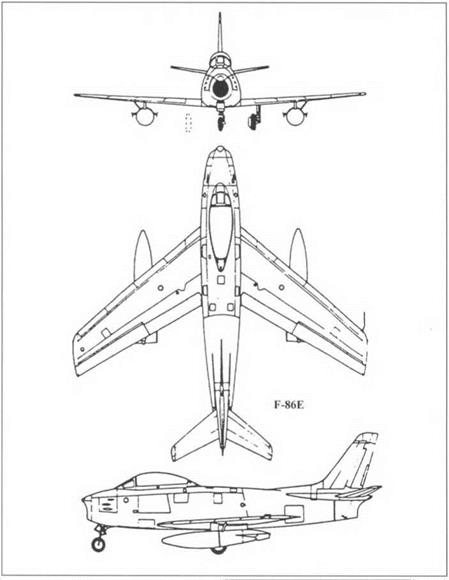THE ERA OF THE JET-PROPELLED AIRPLANE
The era of the jet-propelled airplane began during World War II, and is the era we live in today. A typical example of such an airplane from this era is the swept-wing F-86 fighter, shown in Figure 5.
One of the most pressing aerodynamic challenges during the early part of this era was the proper understanding of compressibility effects. Indeed, the myth of the “sound barrier” had materialized, wherein it was doubted that airplanes could ever fly faster than sound. The essence of the “sound barrier” was the dramatic increase in drag encountered by a body flying near the speed of sound. The gradual understanding of the physical nature of this large drag rise near Mach one is an excellent example of engineering science. The following is a brief synopsis of this story.
In 1920, Frank Caldwell and Elisha Fales at the Army Air Service Engineering Division at McCook Field in Dayton, Ohio, were the first to observe the large drag rise on airfoils beyond some “critical speed” in a high-speed wind tunnel. They did not have a clue as to what was causing it. Lyman Briggs and Hugh Dryden, working for the Bureau of Standards under a contract from the NACA, in 1926
|
|
discovered that these precipitous changes corresponded to the sudden separation of the flow over the airfoil surface. They did not have a clue as to what was causing the flow to separate. Then, in 1934, John Stack and Eastman Jacobs at NACA Langley made the first schlieren photographs of the high-speed flow over an airfoil, and observed the existence of a shock wave on the top surface of the airfoil beyond the critical speed. Suddenly, the pieces were in place. The shock wave was caused by a pocket of locally supersonic flow occurring on the airfoil beyond the critical speed. This shock wave caused the flow to separate from the surface at the point where the shock was touching the surface. The combined pressure effect due to the shock wave and the separated flow caused the drag to greatly increase. The acquisition of this physical knowledge later gave airplane designers some insight as to how to minimize the effect of transonic drag – divergence phenomena. This whole story, only briefly summarized above, is one of the most beautiful examples of the role of engineering science in the evolution of aerodynamics in the twentieth century.
The final case study we will mention here is the development of the swept wing for high-speed airplanes. The concept of the swept wing for such an application was first introduced by the German aerodynamicist Adolf Busemann at the 1935 Volta Congress in Rome. Even though the major leaders in high-speed aerodynamics were present for this meeting, Busemann’s concept went virtually unnoticed. However, by 1939 the Luftwaffe had classified the swept wing concept and was sponsoring research on its aerodynamic characteristics. Later, in 1945, Robert Jones, an extraordinary aerodynamicist at NACA Langley independently conceived the idea for a swept-wing. Many of Jones’ colleagues, especially Theodorsen, were skeptical of Jones’ idea. However, this skepticism quickly melted away when a large bulk of swept-wing data was found in Germany in 1945, and transported to the United States. Quickly thereafter, the swept wing was incorporated on the Boeing B-47 bomber and the North American F-86 fighter (Figure 5). The development of the swept wing concept is an example of engineering science.











